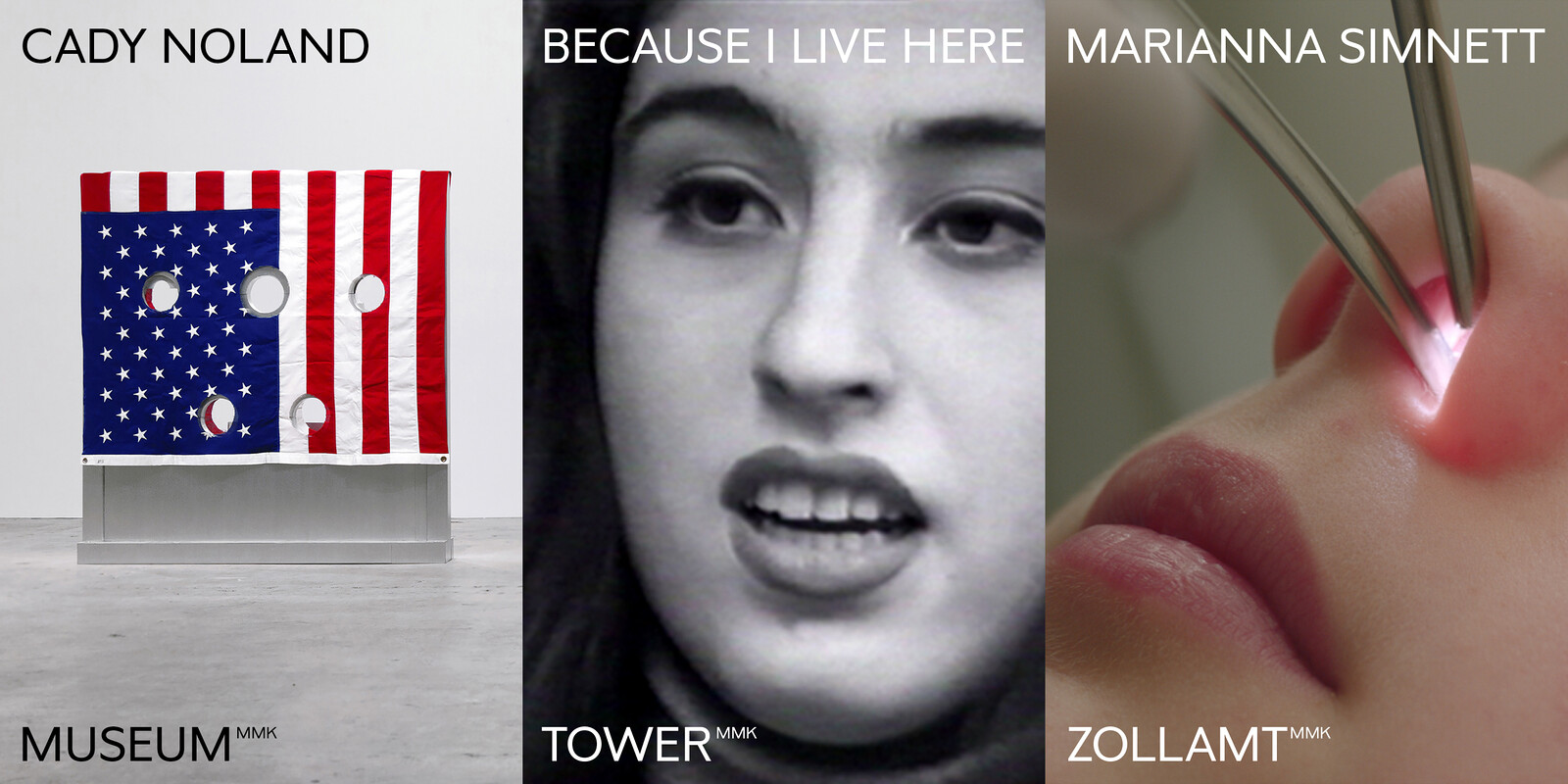Marianna Simnett
Because I live here
October 27, 2018–March 31, 2019
Cady Noland
October 27, 2018–March 31, 2019
MUSEUMᴹᴹᴷ
In modernity, violence finds expression not only in social action, but also in omnipresent objects, facilities and urban structures. The severity of the aggression is condensed in both form and material: The geometric austerity suggests functionality; the reflected light of the metallic surfaces creates distance. The shape, shine and hardness of the resistant materials testify to their strength and power, endowing the objects with immediate brutality. In her works, Cady Noland (b. 1956) uncovers the violence we encounter every day in scenarios of spatial and ideological demarcation. She thus exposes the alleged neutrality of material and form. The supposedly clear distinction between objects and subjects becomes blurred, the unceasing interaction between them evident.
Myth of the American dream, which Noland—with apparent naivety—takes seriously, has become a globalized reality characterized by the glorification of violence, radical individualism, consumption as both stimulus and fulfilment, and conflict in the form of separatism and exclusion.
In her work, barriers, gates and fences are physical and symbolic manifestations that generate publicity and rule out participation. For those unable to comply with the pressure to perform, prostheses such as walkers, picker arms or canes for the blind are the only means of participating in public life. Celebrities, on the other hand, no longer have any choice but to participate. Their involuntary objectification is the prerequisite for the callous treatment they are frequently subjected to. In her 1987 essay “Towards a Metalanguage of Evil,” Noland describes US American society with utter detachment, almost as a psychopath would. It is an analysis that captures global reality today.
Made possible by: ART MENTOR FOUNDATION LUCERNE, Kulturfonds Frankfurt RheinMain, Dr. Marschner Stiftung
Marianna Simnett
October 27, 2018–January 6, 2019
ZOLLAMTᴹᴹᴷ
“‘Head down,’ she said. And I did. She said that I was ‘too beautiful to play outside.’” – Blood In My Milk (2018)
“So we had done her an injustice; she was not at all abnormal.…” Sigmund Freud to Wilhelm Fliess, March 8, 1895
As legend has it, Abbess Saint AEbbe the Younger of Coldingham cut off her nose to avoid being raped by the Vikings. Based on that story, in the work by Marianna Simnett a young girl maims herself. For the sake of freedom, she seeks by these means to escape the threat of male violence.
Unadulterated purity and beauty face impending invasion and sickness. Only absolute sterility offers protection from the onset of disease. In a nightmare-like sequence, removed body parts develop consciousnesses and become vengeful opponents to the body that has shed them. A “minimally invasive” vein operation is performed on a patient unwilling to move. The camera shots blend seamlessly with laboratory experiments on cockroaches whose movements can be controlled by way of targeted shocks. The result is pure horror, not through fiction, but through the realism of the flesh, the body and mechanization from the simple apparatus to the highly developed technology.
Medical, technological and pharmaceutical interventions in the human and animal body alike, and their underlying economic, social and patriarchal power structures, form the dominant narrative in the work of Marianna Simnett. The boundaries, both cultural and ideological, that the protagonists constantly run into are invisible, but none the less violent. The constant control brings about a rigid system with conditional loss of control from which it is impossible to escape unharmed. Simnett’s figures seek their freedom in places where, from a position of powerlessness, they are forced to act while at the same time they are incapable of acting. Their genders and their bodies become objects of negotiation only reconquered bit by bit in the course of the film.
ZOLLAMTᴹᴹᴷ is supported by Jürgen Ponto-Stiftung.
Blood In My Milk was commissioned by the New Museum and produced with the assistance of Arts Council England, Creative Scotland, Comar, Film and Video Umbrella, Matt’s Gallery, Wellcome Collection, and Zabludowicz Collection.
Because I live here
Harun Farocki, Azin Feizabadi, Forensic Architecture, Natasha A. Kelly, Erik van Lieshout, Henrike Naumann, Emeka Ogboh, spot_the_silence, SPOTS, Hito Steyerl, Želimir Žilnik
October 27, 2018–March 31, 2019
TOWERᴹᴹᴷ
Because I live here features 11 artists and artist groups who address themselves to the themes of institutional racism and structural violence in Germany. Their works critically intervene in stereotypical depictions and images that have solidified in clichés. In In-Formation (2005), for example, Harun Farocki offers ground-breaking criticism of the visual violence committed by the depiction of migration and immigration in statistics. The works assembled here create perspectives, imagery and counter-narratives of their own, for instance when Azin Feizabadi superimposes the history of migration with the legend of the patron saint of Dortmund, when Želimir Žilnik portrays the residents of Metzstrasse 11 in Munich, or when the Frankfurt “Sufferhead” beer, newly brewed by Emeka Ogboh, links the German reinheitsgebot (purity law) for beer with the existence of Black Germans. The artists record, supplement and question the construct of a national homogeneity in which racist violence is present in all its forms. As documented in a work such as that by Hito Steyerl, the “normality” of everyday violence represents an attack on society as a whole—a society whose identity is the subject of Erik van Lieshout’s Rotterdam–Rostock (2006), in which he paints a picture of Germany in shades of reservation, forlornness and social failure. Again and again, these artistic documentary works adopt the viewpoints of persons who are subjected to racism, and whose knowledge and experience are often excluded from the discourses conducted within the government authorities and the media.
Press contact:
Christina Henneke
T +49 (0)69 212 37761 / presse.mmk [at] stadt-frankfurt.de


